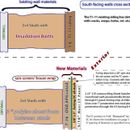Rain screen use in Coastal areas?
I live in Corpus Christi, TX, a hot & humid area that occasionally gets hurricanes. In order to get windstorm insurance, we must purchase it from the Texas Department of Insurance (TDI). The Texas Windstorm Insurance Agency (TWIA) is the organization tasked with determining the “approved” installation methods for both roofing & siding.
It supersedes all local building codes. The local building inspection department requires the homeowner to furnish an inspection report from the TWIA that installation is in accordance with their “approved” methods.
My house was built with T1-11 siding over 15# felt nailed to the wood studs. It has deteriorated badly over it’s 34 year application life and needs to be replaced. I would like to utilize a rain screen and apply Fiber Cement 4’x8′ vertical panels (5/16″) vertically with a simulated stucco finish.
Proposed method of construction: (see attached diagram)
Since the T1-121 formed a structural component of the wall, I would replace it with APA rated 7/16″ OSB nailed to the studs. A “water restive barrier” would then be applied over the OSB. Furring strips 3/8″ x 3″ (either ripped CDX or Coravent Sturdi Strips) would be nailed to the studs to create the drainage gap. The Fiber cement panels would then be fastened with 2 1/4″ round head ring shank Stainless nails as specified by the manufacturer in accordance with NER – 405 nailed through the furring strips, water resistive barrier, OSB and into the studs with the correct penetration depth. (Coravent S3 bottom & top vents would be used as the ventilation inlet & outlet.)
Problem 1):
In discussion with the local TWIA inspector who would approve the installation, he indicates that the only approved methods are contained in EC-23 (TDI pub) for Hardie panel or EC-56 for Maxitile panel for the 2 brands and that neither of those describe the rain screen approach. Has anyone else run into this? Has anyone else gotten a green light on a rain screen install where these types of “approved” methods are in force? Any suggestions on how to get situation resolved?
Problem 2): I confess to now being confused about what is the correct drainage plane to use. My first thought was Tyvek, but I just read something he wrote that said Tyvek was quite permeable to water vapor.
Any help would be greatly appreciated,
Ken
GBA Detail Library
A collection of one thousand construction details organized by climate and house part











Replies
Ken,
I can't help you on your question about the Texas Windstorm Insurance Agency, since I am unfamiliar with the agency's rules.
However, I can help you on your second question: "I confess to now being confused about what is the correct drainage plane to use. My first thought was Tyvek, but I just read something he wrote that said Tyvek was quite permeable to water vapor."
When you install Tyvek, Typar, or asphalt felt on your OSB, it is acting as a water-resistive barrier (WRB). Its purpose is to resist liquid water. The idea is to keep the OSB dry in case any wind-driven rain gets past your siding.
Like most WRBs, Tyvek is both waterproof and vapor-permeable. It lets water vapor through, but not liquid water. The reason that it is vapor-permeable is to allow the OSB to dry to the exterior if it ever gets wet.
To learn more about WRBs, see所有关于Water-Resistive壁垒.
Ken,
Cutting 3" polyiso to fit between the studs would be a big hassle and unlikely to work as well as you'd hope. It would be much more effective to install polyiso continuously over the sheathing, although I'm not sure what effect this would have on your insurance approval.
Martin,
Thanks for getting me back on track with the drainage plane material. Based on the info in "All About water resistive barriers", I think the solution may be for me to go with 15# felt, due to the cost difference & similar performance.
现在我需要的是一些帮助问题# 1.
Thanks,
Ken
TJ,
Yes, it would take a while to fit it in there. I only turned to that approach when I could not find an "approved" assembly in the TWIA approved listings. It was my first choice to layer the polyiso over the sheathing, but it seems that 5" nails aren't in the cards approval wise.
Ken